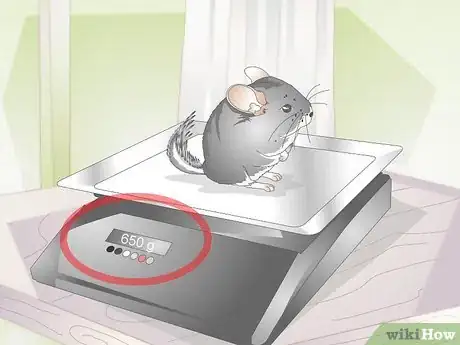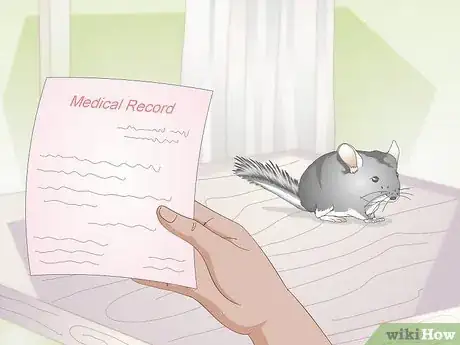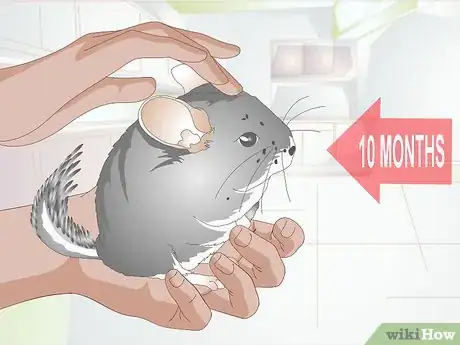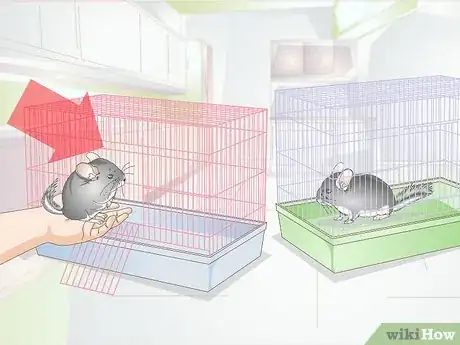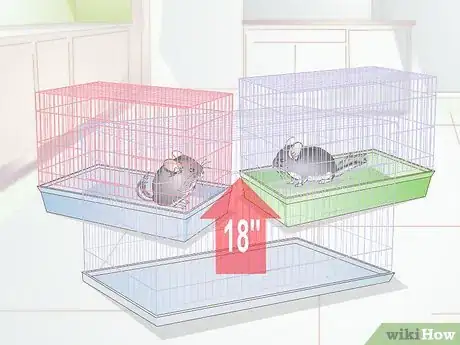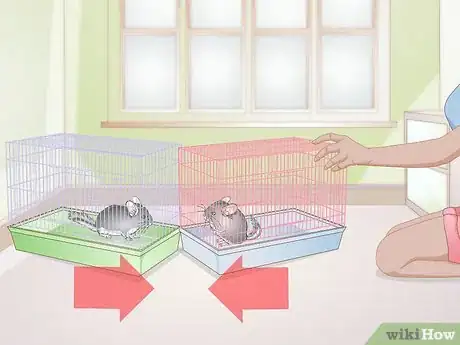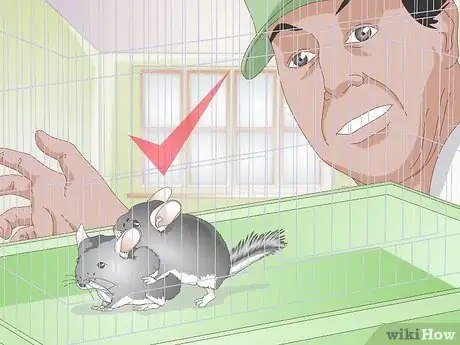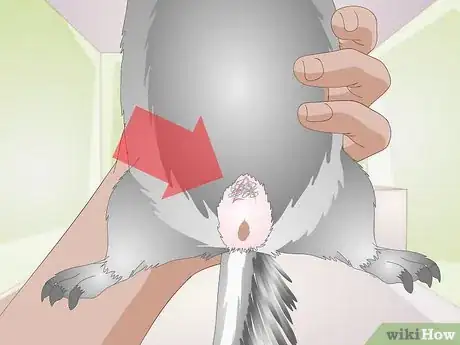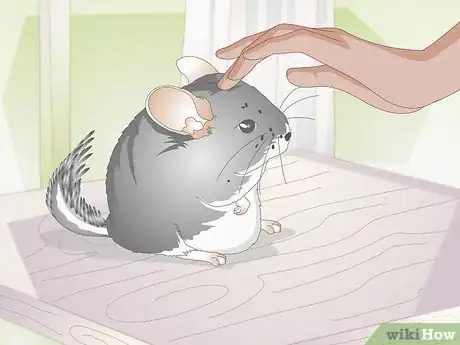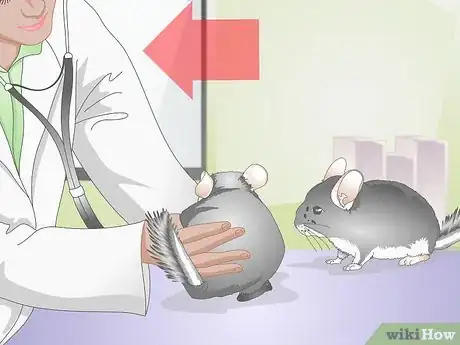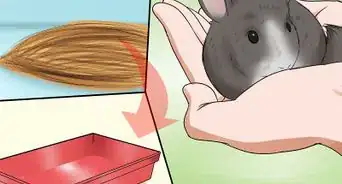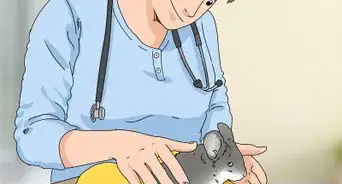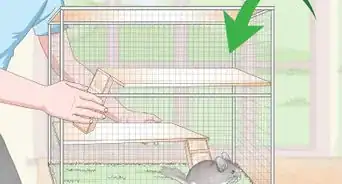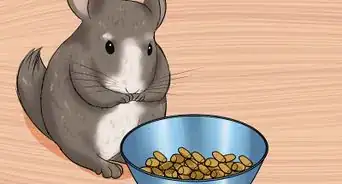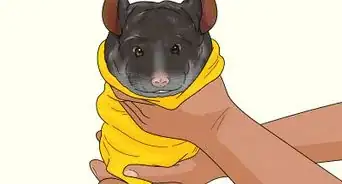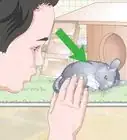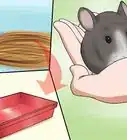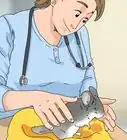This article was co-authored by Pippa Elliott, MRCVS. Dr. Elliott, BVMS, MRCVS is a veterinarian with over 30 years of experience in veterinary surgery and companion animal practice. She graduated from the University of Glasgow in 1987 with a degree in veterinary medicine and surgery. She has worked at the same animal clinic in her hometown for over 20 years.
This article has been viewed 85,154 times.
Chinchillas are popular among pet owners. You may decide you would like to try to breed chinchillas at home to add more furry friends to your household or to sell to other pet owners. Breeding chinchillas requires dedication and preparation, as breeding is big responsibility and should not be done lightly. You will first need to make sure the chinchillas are suitable for breeding and set up an environment for the breeding to take place. You should then allow the chinchillas to breed in a responsible and safe manner.
Steps
Finding Suitable Chinchillas for Breeding
-
1Make sure you have one male and one female chinchilla. You should have a pair of the opposite sex, as you will need the two sexes to breed. You may want to start with one pair of chinchillas for breeding first, as chinchillas can have litters of one to seven babies or kits at a time.[1]
- You can confirm the sexes of the chinchillas by checking by their anus. Hold up their belly and look for a bare patch of skin between the anus and the urethral opening. This is an indication the chinchilla is male.
- You can check if the chinchilla is female by looking for a small slit opening on the anus and no bare patch of skin between the anus and the urethral opening. The distance between the urethral opening and the anus will also be much larger on males than females.
-
2Confirm the weight and appearance of the chinchillas. You should also make sure the chinchillas are at the proper weight and appearance for breeding. This will ensure the female has a healthy pregnancy and the baby chins are born healthy.[2]
- The chinchillas should be over 650g and have clear, dense fur. You may decide to go for a bigger chinchilla that is 800-1000g. But keep in mind larger chinchillas tend to not produce as well as smaller chinchillas.
- You should also inspect the size of the female chinchilla’s pelvis. Her pelvis should be at least the width of a dime and have a length of a dime and a half for her to be a good breeding female. It should be big enough to fit the flat of your thumb in. You can check this by holding the female by the base of her tail and placing your thumb on her bottom, towards her uterus.
Advertisement -
3Check that the chinchillas have good medical histories. You should only breed chinchillas that come from good quality stock, with a healthy medical history. This means the chinchillas do not have a history of medical issues or temperament issues, like fur biting or being high strung. The chinchillas should be in good health and have a calm, relaxed temperament before you consider breeding them.[3]
- The chinchillas should also not carry the lethal gene as this will cause the mother and the baby fetuses stress during pregnancy. This means you should always breed the same breeds of chinchillas with each other. Mating chinchillas of different breeds could lead to weak offspring with poor health.
-
4Make sure the chinchillas are at least nine to ten months old. You should only start breeding chinchillas when they are nine to ten months old so they are sexually mature and fully developed. Breeding older chinchillas will also put less stress on the female chinchilla during pregnancy and birth.[4] [5]
- You may want to wait until the female chinchilla is fully mature, or at least 12 months old. A more mature female chinchilla can make the breeding process much smoother, as younger female chinchillas tend to fight off the male chinchilla rather aggressively.
Setting Up the Breeding Environment
-
1Have separate wire cages for each chinchilla. The chinchillas will need to time to get to know each other and bond before they mate. You will need to have small wire cages for each chinchilla ready. Make sure the cages are made of wire and are 18” high with very small mesh so the chinchillas cannot escape the cage.[6]
- You should also have a larger cage available so you can place the two chinchillas together in the larger cage once they are comfortable around each other and ready to mate. The cage should be big enough for the two chinchillas to move around and mate.
- You may include bolt holes or cubby holes in the larger cage. This will give the male a space to hide of the female does attack him before mating.
-
2Set up wire cages for the baby chinchillas, or kits. You should also set up a cage for the kits so they have housing once they are born. You should use a cage that is no higher than 18” and 1” x ½” or smaller. The kits will likely climb the sides of the cage so it should be small enough for them to drop from a short height.[7]
- Make sure the mesh is small all the way around the cage so the kits cannot climb out of the cage or slide through the holes.
-
3Choose a quiet, isolated area for the breeding. You should set up the breeding cage in a quiet area that does not get a lot of traffic in your home, such as a spare room. Chinchillas are averse to loud noises, strong smells, and being surrounded by new people. You should create a quiet, isolated environment for your chins so they can breed successfully.[8]
- Most chinchillas breed well in rooms that are kept at a cooler temperature, between 52 and 68 degrees Fahrenheit. Try to keep your chinchillas in a room below 75 degrees Fahrenheit at all times.
- You may place a fan in the room to circulate the air and play a radio on low in the room. The radio can help to block any outside noise or noise in your home.
Allowing the Chinchillas to Breed
-
1Introduce the chinchillas to each other slowly. You should always start the breeding process by introducing the chinchillas to each other over a period of time. This will prevent the chinchillas form turning aggressive with each other once it comes time to breed.
- Start by placing each chinchilla in their own cage. Then, place the cages next to each other and notice how they react. The chinchillas may be curious and smell or stare at each other. You can then let them out to play together and see how they react.
- If they still seem curious and not hostile to each other, place one chinchilla in the smaller cage. Then, put the caged chinchilla in the larger cage with the other chinchilla. Open the door of the smaller cage and make sure there is not hostility between them.
- If one chinchilla becomes aggressive, punish him or her by placing it back in the smaller cage. Once both chinchillas are no longer hostile to each other, you can allow both chinchillas to live together in the bigger cage. After some time together in the same cage, they may then be ready to mate.
-
2Wait for the female to be ready to mate. The female chinchilla may need some time to ease into breeding and will come into season every 30-40 days. The female first needs to eject a plug in their vagina, known as the Oestrus Plug before she can come into season or mate. Once the female chinchilla is in season, the male will respond by becoming more excited, wagging his tail, and may chase the female around the cage.[9]
- Be prepared for the female to show some resistance to the male at first. She may vocalize her distress by standing on her hind legs and spraying the male with urine. She may also whine or make loud noises.
- Some females may also try to attack the male before mating. This is why it is important that the cage be large enough for the male to hide or retreat when he is being attacked. The male may retreat to cubby holes or bolt holes in the cage in the event of an attack.
-
3Allow the male and female to mate. Make sure you supervise the male and the female, especially if they seem ready to mate. The mating process can happen rather quickly. It may also be pretty aggressive, as the male tends to pull at the female’s fur as he mounts her.[10] [Image:Breed Chinchillas Step 4 Version 2.jpg|center]]
- Do not be alarmed if there is clumps of fur in the cage due to the male pulling at the female, as this is natural. You should only separate the chins if you see the female turn and attack the male by biting or scratching him.
- During the mating process, a copulation plug develops. It will be excreted from the female once the breeding is done. This plug appears as a waxy substance surrounded by a cornified layer of the vaginal wall and is about 1” long. You can check for this plug once the mating is over to confirm the chins have bred.
-
4Check the male for a “hair ring”. Once the chins have mated, you should check the male for a “hair ring”, which is an accumulation of hair that accumulates inside the penile sheath. Most males will clean their penis after mating but they may be hindered by the large amount of hair loss during mating.[11]
- If you notice hair around the male’s sheath, use petroleum jelly to gently lubricate it. Then, tease open the hair ring and carefully cut it off with small scissors.
- A hair ring that is not removed quickly can lead to serious injury to the male’s penis and possibly be fatal for the male if it is not addressed.
-
5Confirm the female is pregnant. Female chinchillas have a long pregnancy, with a gestation period of 110 days. The female may not look much different until a few weeks before she is due. She may sleep more on her side, eat less food, and drink more water.[12] [13]
- The female’s six teats may also become larger and more pink by day 65. Her nipples may get longer and redder by day 85 of her pregnancy. You may also notice the kits moving inside of the female in the last few weeks of her pregnancy.
-
6Take the chinchillas to the vet if they have difficulty breeding. Some chinchillas have difficulty breeding and may not be successful even after a few attempts at mating. You should bring the chinchillas to the vet to get them checked for healthy issues that could be causing infertility or make it difficult for them to breed.[14]
- The main causes of infertility in chinchillas are genetic factors, nutritional deficiencies, nonviable sperm, a hormone imbalance, or metritis, an inflammatory issue in the female’s uterus.
- The vet should do a full examination of the chinchillas and x-ray their abdominal area. The vet may then suggest treatment for the chinchillas so they have a higher likelihood of mating and conception.
References
- ↑ https://chinchillacare.org/breeding-babies/
- ↑ http://www.sunsetchinchillas.com/Breeding.shtml
- ↑ http://www.chinchillachronicles.com/breeding_chinchillas.html
- ↑ http://www.chinchillachronicles.com/breeding_chinchillas.html
- ↑ http://www.cheekychinchillas.com/breeding.html
- ↑ http://www.cheekychinchillas.com/breeding.html
- ↑ http://www.sunsetchinchillas.com/Breeding.shtml
- ↑ http://www.sunsetchinchillas.com/Breeding.shtml
- ↑ http://www.chinchillachronicles.com/breeding_chinchillas.html
- ↑ http://www.chinchillachronicles.com/breeding_chinchillas.html
- ↑ http://www.chinchillachronicles.com/breeding_chinchillas.html
- ↑ http://www.cheekychinchillas.com/breeding.html
- ↑ http://www.merckvetmanual.com/pethealth/exotic_pets/chinchillas/breeding_and_reproduction_of_chinchillas.html
- ↑ http://www.chinchillachronicles.com/breeding_chinchillas.html
About This Article
To breed chinchillas, start by making sure you have a male and female chinchilla that are the same breed, and are at least 10 months old. Then, keep the chinchillas in separate cages that are next to each other so they can interact without the female attacking the male. When the female is ready to mate, put the chinchillas together in a cage, and separate them if the female becomes aggressive. Finally, look for the female to excrete a waxy plug from her vagina to confirm that that the breeding was successful. For advice from our Veterinary co-author on how to tell if your chinchilla is pregnant, read on!

